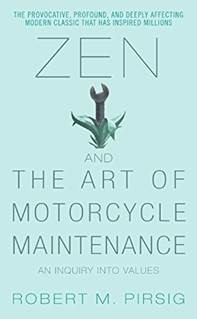Author: Robert M Pirsig
Genre: Philosophical fiction, Autobiography

To start with, it has an awesome title with Zen, Art, and Motorcycle maintenance in it. It sounds cool, wise, and highly intellectual at the same time. This book was published in 1974 and has been hailed as massive best seller for decades since its publication. It has inspired millions to seek their own way of life, without having an aversion to technology, nor a naive faith in it. But it was not a sellout success from the day it was written.
It was rejected by 121 publishers. The 122nd Publisher (William Marrow and Co.) believed that the book would be successful. The publisher’s internal recommendation stated, “This book is brilliant beyond belief, it is probably a work of genius, and will, I’ll wager, attain classic stature.”
Now if you are thinking of picking up this book to learn about motorcycle maintenance, you would be a sorely disappointed. Also, if you feel your Zen quotient would rise with some cryptic short zen stories out of this, maybe you will be slightly off. What remains true is that it is an inquiry into values. Values held dear by the author in present and in past and those held dear by other people around him. Like a working parts of motorcycle, this book has many moving parts and is a bit complex. And if you decide to go on the ride, it will be a thrilling adventure and experience which may change you.
This book is a fictionalized autobiography of the author. It sometimes feels like, it is autobiographical novel other times as a novelized autobiography. Some call it a travelogue which develops into a journey of self re-discovery. Along the way the authors makes us stop at several “Chautauquas” which are like community education programs done in US with lot of show and pompous.

The author/narrator is on a road trip with his son Chris, riding a bike through vast expanses of vacant lands and faces some thunderstorms. Amidst such journey, while he is focused on riding, he shares his thoughts and perceptions on how he see the world. Suddenly, his past resurfaces amidst a thunderstorm. A past, he has forgotten. A past, wherein he was driven mad with obsession on topic of quality. He had to undergo electric shocks to treat his madness.
The book is punctuated with several philosophical discourses around topics like Romantic vs Practical way of looking at things, Need for continuous focus and improvement vs letting go of control, History of Philosophy, Philosophy of science, Nature of good or quality and pursuit of excellence. The author binds it all together by reconciling with his past mad self which he had forgotten with the shock therapy. The great thing about the book is how effortless the author is able to bind the novel narrative and philosophy together.
Now before you dismiss his ideas as ravings of mad man, lets understand few things about the author. Robert Prisig (1928 -2017) was a legend in his own way. He was a child prodigy with IQ of 170 at age of 9. He was a student of biochemistry at University of Minnesota. Later he joined World War 2 and was based out of Korea for some time. He returned to US and competed his graduation in Law in 1950. He then moved to India and graduated from Banaras Hindu University on topic of Hindu Philosophy. He then moved to University of Chicago for further studies in Philosophy.
He suffered a mental breakdown and spent a lot of time in hospitals between 1961 and 1963. He was diagnosed with schizophrenia and received electroconvulsive therapy on several occasions. He was a self taught navigator expert and crossed the Atlantic two times. He lived till a ripe old age of 88 and passed away in 2017.
Three Takeaways from the Book:

1. Develop right attitude with your work. – At the beginning of the novel, the author keeps observing his friend John, who is on the bike trip with him. Despite having a newer and more expensive bike, John doesn’t want to learn about technical aspect of the bike. He gets frustrated with some minor problems but prefers to rely more on the mechanics/technicians to solve even basic problems of bike maintenance. He finds technology a bit daunting and kind of repulsed by attention and care author shows while working his motorcycle maintenance.
The author comments two types of personalities we would find in life. Romantics who live in the present, like John, who enjoy only bike riding. They prefer to have Gesallt viewpoints of being in the present moment only. This viewpoint makes people view technology as ugly and repulsive. This makes them try to force fit all their experiences in the romantic viewpoint. We see this often when people hopelessly give up or start hating technology and other changes which impact their romantic viewpoint.
The author initially appears to take the other side, the Classical viewpoint, which he believes is a more rational approach. In this one seeks to understand more details, inner working and master mechanics. But later, he shows that he understands both the viewpoints. The author concludes that having the right attitude towards things would help you understand them better. With the right attitude even a dull and tedious drudgery like motorcycle maintenance may become an enjoyable and pleasurable pastime. He suggests such a combination of rationality and romanticism can potentially bring a higher quality of life.
2. Learn to define Quality / High standards – The author makes a strong case on how we all know what is good and what is having high quality but sometimes it is so difficult to define and describe it. He refers to early Greek philosophers who did not distinguish between “Truth” and “Quality”.
This again is related to the romantic and classical viewpoints. Imagine how quality would be defined by someone with a romantic view point and someone with a classical bend of mind. Does the definition of quality becomes different for both kind of people. The minute you define and classify it correctly the boundaries between romantic and classical viewpoint starts to dissolve.
As leaders in organizations, we would end up leading several people who may have romantic or classical viewpoints. To deliver good work together, it is absolutely important that what is defined as good work is viewed in same way by everyone.
3. Be aware of your “Gumption Traps” – Gumption is defined sometime as your ability to take initiative or sense of common sense. The author shares in insights on 2 types of Gumption traps called “setbacks” and “Hang-ups”. These are events and mindsets which will cause one to lose enthusiasm, traction, and demotivate from either completing the work or even starting a new work/project.
Setbacks arise from external events sometimes beyond your control. Lack of knowledge and lack of progess may sometimes seem as setback, leading us to take longer breaks or focus attention on other endeavors. The best way to deal with setback is to be meticulous and slow. Taking notes to go in a logical order and being conceptually clear and paying attention to instructions.
And Hang-ups are completely internal factor and include anxiety, boredom, lack of prioritization and lack of awareness of what we need to complete our work. Dealing with hangs up can be made more effective by breaking down the thing in small parts and focusing intensely on small sections to get continuous wins. Sometimes even taking break away from such work helps.
Why should you read this book: In the beginning of the book, the author is continuously encouraging his son Chris, who is riding behind him, on the motorcycle, to look around and be more observant of his surrounding and fields and birds flying around. But Chris continuously misses looking at things. Author doesn’t understand why his son is completely oblivious to things which are so important and easily visible to him. He is mistaken that his son sitting behind has the same view of things and same level of understanding. Towards the end of the book, Chris makes an interesting statement. He says. “Dad, I can see over your shoulder now. I could never see over your shoulders before”. In his own way, Author drive a point about how many times we perceive that people under our care and working with us would have the same viewpoint. But often, they have their reasons for doing and seeing things their way. Once you go through the journey with someone, and learn to look over their shoulders, you would be able to see things your own way.

Hopefully, this ride with the Author and his son will open your eyes to some new insights about how you perceive people, processes, quality, rationality, technology, Zen, Duality of Romantic and Classical approach and taking road trips on journey of self discovery.
Goodreads Link: Zen and the Art of Motorcycle Maintenance: An Inquiry Into Values by Robert M. Pirsig | Goodreads

 This information will never be shared with third party
This information will never be shared with third party
The being in a Car as a passive participant vs being in the scene when on a bike is a nice comparison to understand what the Metaverse really really means. Being in the Car is like being a passive participant on the internet and being in the internet (the Metaverse) as part of the scene is being on the motorbike.
Amazing review. As the story goes the journey continues, the saying goes true, “The journey is more beautiful and enriching than the destination”
Great review, totally changed my perspective towards the book. Definitely gonna be the next book I pick up!!!